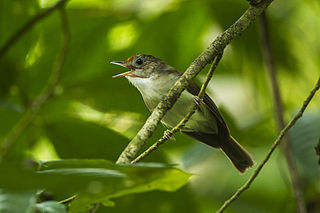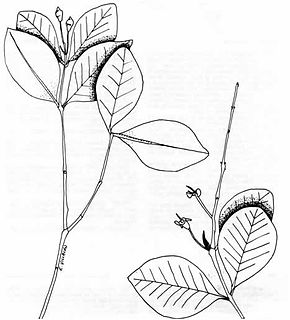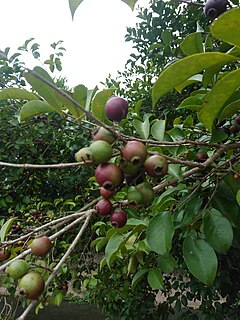
Guava is a common tropical fruit cultivated in many tropical and subtropical regions. The common guava Psidium guajava is a small tree in the myrtle family (Myrtaceae), native to Mexico, Central America, the Caribbean and northern South America. Related plants may also be called guavas; they belong to other species or genera, such as the pineapple guava, Feijoa sellowiana. In 2019, 55 million tonnes of guavas were produced worldwide, led by India with 45% of the total. Botanically, guavas are berries.

Psidium is a genus of trees and shrubs in the family Myrtaceae. It is native to warmer parts of the Western Hemisphere.

Psidium cattleyanum , commonly known as Cattley guava, strawberry guava or cherry guava, is a small tree in the Myrtaceae (myrtle) family. The species is named in honour of English horticulturist William Cattley. Its genus name Psidium comes from the Latin psidion, or "armlet." The red-fruited variety, P. cattleyanum var. cattleyanum, is commonly known as purple guava, red cattley guava, red strawberry guava and red cherry guava. The yellow-fruited variety, P. cattleyanum var. littorale is variously known as yellow cattley guava, yellow strawberry guava, yellow cherry guava, lemon guava and in Hawaii as waiawī. Although P. cattleyanum has select economic uses, it is considered the most invasive plant in Hawaii.

The gray thrasher is a medium-sized passerine bird belonging to the family Mimidae. It is endemic to the Baja California peninsula of Mexico.

The common tody-flycatcher or black-fronted tody-flycatcher is a very small passerine bird in the tyrant flycatcher family. It breeds from southern Mexico to northwestern Peru, eastern Bolivia and southern, eastern and northeast Brazil.

Humblot's flycatcher or the Grand Comoro flycatcher, is a small passerine bird belonging to the Old World flycatcher family. It is the only member of its genus. Humblot's flycatcher is endemic to the island of Grand Comoro in the Comoros where it inhabits forest on the slopes of Mount Karthala. The scientific name commemorates the French naturalist Léon Humblot.

Psidium guajava, the common guava, yellow guava, lemon guava, or apple guava is an evergreen shrub or small tree native to the Caribbean, Central America and South America. It is easily pollinated by insects; when cultivated, it is pollinated mainly by the common honey bee, Apis mellifera.

Pleurodema cinereum is a species of frog in the family Leptodactylidae. It is found in the Andes in northwestern Argentina, Bolivia, and southeastern Peru. Its common name is Juliaca four-eyed frog, after its type locality, Juliaca. Pleurodema borellii is possibly a junior synonym of this species.

The cinereous conebill is a species of bird in the tanager family Thraupidae. The term cinereous describes its colouration. It is found in Bolivia, Chile, Colombia, Ecuador, and Peru. Its natural habitats are subtropical or tropical moist shrubland, subtropical or tropical high-altitude shrubland, and heavily degraded former forest.

The scaly-crowned babbler is a species of bird in the family Pellorneidae. It is found in Brunei, Cambodia, Indonesia, Laos, Malaysia, Thailand, and Vietnam. Its natural habitat is subtropical or tropical moist lowland forest.
The ashy darter is a species of freshwater ray-finned fish, a darter from the subfamily Etheostomatinae, part of the family Percidae, which also contains the perches, ruffes and pikeperches. It is endemic to the eastern United States.
Memecylon cinereum is a species of plant in the family Melastomataceae. It is found in Malaysia and Singapore. It is threatened by habitat loss.
Psidium claraense is a species of plant in the family Myrtaceae. It is endemic to Cuba. It is threatened by habitat loss.
Psidium dumetorum, the Jamaican guava or Jamaican psidium, was a species of plant in the family Myrtaceae endemic to Jamaica. It is now extinct.
Psidium harrisianum is a species of plant in the family Myrtaceae. It is endemic to Jamaica.
Psidium havanense is a species of plant in the family Myrtaceae. It is endemic to Cuba. It is threatened by habitat loss.
Psidium pedicellatum is a species of plant in the family Myrtaceae. It is a fruiting shrub or small tree endemic to Ecuador.
Psidium rostratum is a species of tree in the family Myrtaceae. It is endemic to Peru and considered as a vulnerable species by the IUCN. This species can attain a height of 10 meters.

Psidium sintenisii is a species of flowering plant in the myrtle family, Myrtaceae. It is endemic to Puerto Rico, where it is known from three or four small subpopulations, mainly within El Yunque National Forest. It grows in wet mountain forest habitat. Its common names are Sintenis' guava and hoja menuda.

Psidium rufum is commonly known as the purple guava. It is endemic to Brazil and bears an edible fruit. Psidium rufum var. widgrenianum is listed on the IUCN Red List vulnerable species (Plantae).













